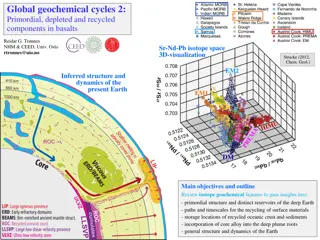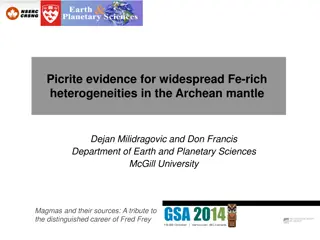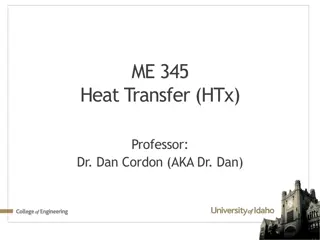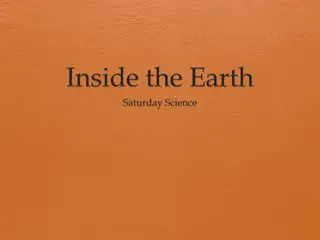Understanding Terrestrial Planets and Core Dynamics
Exploring the core-mantle interaction from the early Hadean period to present times reveals intriguing questions about the outer core's electrical conductivity, geodynamo sustainability, and inner core characteristics. Studies indicate challenges in maintaining the geodynamo, potential heat sources
9 views • 48 slides
Insights from the International Kimberlite Conference on Diamonds and Geology
Delve into the world of diamond mining and geology with a focus on Kimberlites. Explore topics such as diamond deposits exploration, mantle petrology, and economic geology presented by experts in the field. Discover the origins and evolution of Kimberlites, advancements in prospecting techniques, an
6 views • 8 slides
Insights into Earth's Geochemical Cycles and Isotopic Evolution
Explore the primordial, depleted, and recycled components in basalts to understand deep Earth reservoirs, recycling paths, and core-mantle dynamics using isotope geochemistry. Learn about radioactive decay systems, mantle array evolution, and U-Th-Pb systematics in planetary differentiation.
6 views • 30 slides
Heating of Crude Oil
The process of heating crude oil in petroleum refineries involves various types of furnaces and heat distribution methods. The furnaces can be categorized into box, cylindrical, and radiant wall types, each with separate radiation and convection sections. Design considerations include heat transfer
1 views • 24 slides
Understanding Atmospheric Thermodynamics in Second Stage Lecture
Explore key concepts in atmospheric thermodynamics, including condensation level, free convection level, and the use of thermodynamic diagrams. Learn about the process of condensation, stability levels in the atmosphere, and the significance of free convection in weather patterns. Discover why therm
0 views • 27 slides
Understanding Convection Currents in Earth's Systems
Convection currents refer to the movement of heat by fluids like liquids and gases, transferring heat from one place to another. They play a significant role in the geosphere, atmosphere, and hydrosphere of the Earth, influencing phenomena such as plate tectonics, winds, and ocean currents. In the g
0 views • 12 slides
Understanding Cooking Methods: Conduction and Convection Explained
Cooking methods like conduction and convection are fundamental in culinary arts. Conduction involves direct heat transfer through matter, while convection utilizes the movement of fluids for heat transfer. Gravity and buoyancy play crucial roles in natural convection processes, resulting in efficien
1 views • 45 slides
Respiration in Mollusca: Adaptations to Different Habitats
Mollusca exhibit various modes of respiration depending on their habitat - aquatic, terrestrial, or amphibious. Different respiratory organs are modified accordingly, such as ctenidia or gills for aquatic species, pulmonary sac for aerial species, and mantle or integument for those lacking specific
0 views • 17 slides
Understanding Phytogeography: Geographical Distribution of Plants
Phytogeography, the branch of botany dealing with plant distribution, encompasses principles, history, major biomes, and India's divisions. It explores phytochoria, natural floristic areas based on species distribution. The study's history dates back to Theophrastus and Linnaeus, with Humboldt and H
0 views • 7 slides
Understanding Heat Energy Transfer and Principles
Heat energy is the result of particle movement in solids, liquids, and gases. It can be transferred through conduction, convection, and radiation. Conduction occurs through direct contact, convection involves the movement of fluids, and radiation transfers heat through empty space. Understanding how
1 views • 14 slides
Understanding Processes Shaping Earth: Lithosphere, Plate Tectonics, and Effects
Explore the components of our planet, such as the lithosphere, hydrosphere, atmosphere, and biosphere. Learn how the lithosphere, consisting of the Earth's crust and top solid mantle, interacts through plate tectonics, causing movements that shape the Earth's surface. Discover the concept of Pangaea
0 views • 31 slides
Understanding Heat Transfer: Conduction, Convection, Radiation
Explore the concepts of conduction, convection, and radiation in heat transfer through an engaging video. Learn how thermal energy is transferred through solids, liquids, and gases, and understand the role of insulation in preventing heat transfer. Discover why hot water rises and cold water sinks,
0 views • 5 slides
Journey to the Center of the Earth: A Geographical Exploration
Delve into the intricate layers of the Earth's interior, from the solid crust to the molten mantle and the metallic core. Explore the composition, thickness, and characteristics of each layer, revealing the fascinating mysteries beneath our feet.
0 views • 13 slides
Understanding Heat Transfer in Science
Investigate and understand the movement of heat between objects through conduction, convection, and radiation. Learn to compare materials that conduct heat with insulating materials, describe heat transfer processes, and design experiments to study heat energy movement. Explore the use of ratio reas
0 views • 31 slides
Explore Convection Currents Lab Activity
Engage students in a hands-on lab activity to observe convection currents in action. The agenda includes bell work about convection, a hypothesis on confetti paper movement in hot water, detailed lab procedures, drawing conclusions with CER format, and thought-provoking conclusion questions related
0 views • 7 slides
Helium Abundance Variations in MORB vs OIB Geochemistry
In the study of helium abundances in Mid-Ocean Ridge Basalts (MORB) and Ocean Island Basalts (OIB), it is found that degassed MORB has higher concentrations of 3He compared to OIB. Various models and scenarios explain the differences in 3He/4He ratios in different geological settings, such as carbon
1 views • 14 slides
Exploring Plate Tectonics and Earth's Structure for 5th Grade Science
Delve into the world of plate tectonics with a focus on Earth's layers, crust, mantle, and core. Understand how tectonic plates move and learn about continental drift and the concept of Pangea. Explore evidence of Pangea, sea floor spreading, and the fascinating geological processes that shape our p
0 views • 23 slides
Picrite Evidence for Fe-Rich Heterogeneities in Archean Mantle
Terrestrial basalts generally have low FeO content, but Archean mafic/ultramafic rocks show high FeO levels inconsistent with typical sources. Neoarchean Fe-rich magmatism is observed, with ferropicrites displaying unique geochemical characteristics. This study explores the widespread presence of Fe
0 views • 17 slides
Modeling Natural Convection Cooling of a Vacuum Flask in COMSOL
This example demonstrates the modeling of natural convection cooling in a vacuum flask holding hot coffee using COMSOL. It compares two approaches to describe thermal dissipation, focusing on calculating the flask's cooling power over time. Results include temperature analysis, heat transfer coeffic
0 views • 11 slides
Atmosphere, Ocean Currents, Weather Maps, & Air Mass TEKS Review
Explore key concepts related to atmosphere, ocean currents, weather maps, and air mass in this TEKS review. Understand the factors contributing to Earth's uneven heating, the role of convection in ocean currents, the energy sources that drive ocean convection, and the effects of heating on air densi
0 views • 21 slides
Convection Parameterization for Low-CAPE Environments
Many global Numerical Weather Prediction systems face challenges predicting convective activity in low-CAPE environments. This study introduces a convection parameterization scheme based on moisture convergence to better represent convective effects. The scheme focuses on the triggering function, up
1 views • 38 slides
Understanding Earth's Structure and Continental Drift Theories
Dutch mapmaker Abraham Ortelius noted the jigsaw fit of continents, leading to the theory of continental drift. Alfred Wegener proposed the movement of continents based on geological evidence, influencing plate tectonics theory. Earth's layers vary from the thick mantle to the solid inner core due t
0 views • 27 slides
Understanding Heat Transfer in Scientific Experiments
Explore various scientific experiments related to heat transfer, including determining energy produced by batteries, heat convection in gases and liquids, detecting warmth through a door, energy transformations in the Earth system, and optimizing solar heaters. Learn about conduction, convection, ra
0 views • 16 slides
Understanding Mature Convection Distribution Over Europe
Analyzing the time and space distribution of mature convection over Europe based on MSG Airmass product from Slovak Hydrometeorological Institute. The data covers various timeframes and processing steps, highlighting the dependence on Sun elevation, daytime hours, and monthly variations. Statistical
0 views • 11 slides
Embryology of Spinal Cord and Vertebral Column Development
Explore the fascinating embryological journey of the spinal cord and vertebral column development, covering topics such as neural tube formation, layers of the spinal cord, subdivisions of mantle and marginal zones, chondrification, ossification stages, spina bifida types, and more. Dive into the st
1 views • 15 slides
Understanding Heat Transfer in Convection: Key Parameters and Correlations
Explore the fundamentals of heat transfer in convection, focusing on external flow, important dimensionless parameters like Nusselt and Sherwood numbers, empirical correlations, film temperature concept, and local laminar flat plate correlations. Learn about key concepts and equations used in analyz
0 views • 26 slides
Understanding Torsion in Gastropods: Mechanism, Effects, and Significance
Torsion is a key developmental process in gastropods, involving the rotation of the visceral mass, mantle, and shell. This rotation has significant effects on the positioning of organs and overall physiology in gastropods. The process of torsion is crucial during larval development, providing advant
0 views • 6 slides
Debunking the Galapagos Hotspot: Plate vs. Plume Controversy
Situated in the Pacific Ocean, the Galapagos Islands have sparked a debate on whether they were formed by mantle plumes or the spreading ridge. Evidence refuting the plume theory includes variations in isotopic compositions, non-progressive volcanic activity, unique morphology, seismic findings, and
0 views • 9 slides
Earth's Layers and Plate Tectonics Overview
Earth's layers, including the core, mantle, and crust, have different properties and compositions that shape the planet's structure. Scientists study seismic waves to understand Earth's interior. Plate tectonics play a crucial role in shaping the planet's surface features through the movement of lit
0 views • 13 slides
Exploring Diverse Igneous Geology in and around the Columbia Hills
Studying the diverse igneous geology in and around the Columbia Hills provides insights into Martian atmosphere, volatile budget, age, source characteristics, cooling history, and more. Researchers have uncovered valuable information by coupling unaltered igneous rocks with meteorites and surface sp
0 views • 19 slides
Understanding Heat Transfer: Conduction, Convection, and Radiation
Heat transfer is a fundamental process that occurs through conduction, convection, and radiation. Conduction involves the transfer of heat between particles through direct contact, while convection moves heat within fluids and gases through currents. Radiation is heat transfer through electromagneti
0 views • 13 slides
Turbulence Kinetic Energy (TKE) Budget Equations Overview
The Turbulence Kinetic Energy (TKE) budget equation explores the different terms contributing to the generation and consumption of turbulence in the atmosphere. It delves into the effects of buoyant production/consumption, mechanical (shear) production, and the importance of Term III in free convect
0 views • 12 slides
Understanding Heat Transfer Methods and Insulation
Explore the various methods of heat transfer such as conduction, convection, and radiation, along with the roles of conductors and insulators in managing heat. Discover why metals feel cool to the touch, how insulated containers work, and the mechanism behind a Thermos. Delve into the concepts of co
0 views • 14 slides
Understanding Earth's Internal Structure: A Geographical Perspective
Deep parts of Earth's interior are studied indirectly through geophysics, including seismic waves, magnetic fields, gravity, and heat. Seismic studies reveal Earth's layers - crust, mantle, and core - each with distinct properties and compositions. The lithosphere, comprising the upper mantle and cr
0 views • 12 slides
Journey to the Earth's Layers
The Earth's structure consists of four main layers: the crust, mantle, outer core, and inner core. The crust is the thin, rocky layer we see on the surface, while the mantle is a solid layer that flows like a viscous liquid. The outer core is a hot, melted layer of iron and nickel, and the inner cor
0 views • 10 slides
Geoneutrinos and Earth's Thermal Power Budget Analysis
Geoneutrinos play a crucial role in understanding the Earth's heat budget. Researchers like Bill McDonough and others utilize geoneutrino studies to investigate radioactive decay driving the Earth's internal processes, mantle convection, plate tectonics, and more. By measuring geoneutrinos, valuable
0 views • 12 slides
The Theory of Continental Drift and Plate Tectonics
Scientist Alfred Wegener proposed the theory of continental drift, noticing how continents could fit together like pieces of a puzzle. His idea evolved into the concept of plate tectonics, explaining the movement of Earth's lithosphere. This model highlights the dynamic nature of the Earth's surface
0 views • 4 slides
Exploring the Structure and Phenomena of the Sun
Discover the intricate balance and core structure of the Sun, maintained by hydrostatic equilibrium. Energy moves through radiation and convection zones, with convection manifesting as granulation on the photosphere. Eclipses, such as solar eclipses, provide unique opportunities to witness celestial
0 views • 12 slides
Understanding Extended Surface Heat Transfer in Thermal Fluids Laboratory
This laboratory explores heat transfer in a single cylindrical extended surface (a fin) under free and forced convection to understand fin effectiveness and influencing parameters. Various types of fins like rectangular, triangular, annular, and pin fins are discussed, along with primary modes of he
0 views • 19 slides
Understanding Heat Transfer: A Comprehensive Overview
Heat transfer is a fundamental concept in physics, where energy moves from hot to cold objects through conduction, radiation, and convection. Heat is not a substance but a form of energy that speeds up molecules. Conduction transfers heat between substances in direct contact, while convection involv
0 views • 13 slides







































